Mad and magnificent, overwhelming and exhilarating, this crazy capitol captivates with its fascinating mix of ancient and modern. A side trip takes in pristine beaches and tropical waters that wash away all cares.
Next up, Mexico City and Zihuatanejo on Smart Travels.
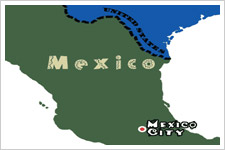 The air is un-breathable,...the traffic mind boggling,...earthquakes regularly rock the region, the city’s sinking into mud...and poverty is commonplace. Yet this capitol of Mexico positively sizzles with energy, determination and zest. It’s a madhouse brimming with art, culture, high cuisine and nightlife. The past never feels far away and its people are a vibrant mix of cultures from a tumultuous history. More than 20 million people inhabit this frenetic city, making it one of the worlds largest.
The air is un-breathable,...the traffic mind boggling,...earthquakes regularly rock the region, the city’s sinking into mud...and poverty is commonplace. Yet this capitol of Mexico positively sizzles with energy, determination and zest. It’s a madhouse brimming with art, culture, high cuisine and nightlife. The past never feels far away and its people are a vibrant mix of cultures from a tumultuous history. More than 20 million people inhabit this frenetic city, making it one of the worlds largest.
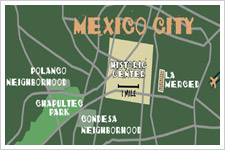 Perhaps it’s the chaos of Mexico City that makes the quiet moments so precious—a fountain splashing in a neighborhood park,...a gripping stone stare from the ancient past,….a back street cafe. Optimistic and warm, the people make this mega-metropolis feel like a small town.
Perhaps it’s the chaos of Mexico City that makes the quiet moments so precious—a fountain splashing in a neighborhood park,...a gripping stone stare from the ancient past,….a back street cafe. Optimistic and warm, the people make this mega-metropolis feel like a small town.
Mexico City takes a little getting used to. The altitude alone can make you short of breath, not to mention the frenzy and fumes. Kicking back in one of Mexico City’s neighborhoods, exploring a little cantina or catching a mariachi band—all help bring the city down to size.
Built on an island in a lake and ringed by active volcanoes, Mexico City once dazzled with its natural beauty. Today smog obscures the mountains most days and the lake was long ago filled in. The beauty of the city now comes from its vitality, from its charming neighborhoods, its restaurants and nightlife.
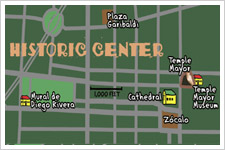 Our exploration of Mexico City begins in the historic center. We take in several markets and stroll through Chapultec Park, the Polanco and Condesa neighborhoods. We’ll also take excursions to the ruins of Teotichuacan...and gorgeous beaches at Zihuatanejo.
Our exploration of Mexico City begins in the historic center. We take in several markets and stroll through Chapultec Park, the Polanco and Condesa neighborhoods. We’ll also take excursions to the ruins of Teotichuacan...and gorgeous beaches at Zihuatanejo.
The Zocalo, the vast square in the center of Mexico City, is the spot where it all began, when this was an Aztec city called Tenochtitlan. Built on an island in the middle of a large lake, the city’s main temple, the Temple Mayor, rose 90 feet in the air. Today, performers recreate Aztec ceremonies and dances in the Zocalo.
When a small group of Spanish men led by Hernan Cortes came to conquer Tenochtitlan in 1519, they approached the city with awe. Their chronicler wrote : "These temple-pyramids...rising from the water, all made of stone, seemed like an enchanted vision...Cortes soon destroyed everything that had so impressed his men."
The Temple Mayor Museum contains a treasure from the temple, a round stone that electricians accidentally unearthed in 1978. Aztec myth describes how the mother of moon Goddess Coyolxauhqui gave birth to a son in full armor. He promptly cut the head and limbs off his sister on way to becoming the supreme God of the sun. This grizzly murder became the prototype for the Aztec rituals in which humans were sacrificed so that the sun would continue to rise each day. The museum also exhibits many artifacts excavated from the great temple of Tenochtitlan.
After Cortes razed the temple Mayor, he erected a catholic church. Today’s cathedral was later re-built in the 16th century.
If the Zocalo is the soul of Mexico City, the main market, La Merced is its beating heart. Mounds of dried chilies, every bean imaginable, fresh luscious fruits...even magic spells are up for sale here.
Europeans discovered many new foods when they journeyed to the new world. Corn, tomato, chili pepper, beans, pineapple, cacao (that’s chocolate) and squash to name a few.
There is so much here it can take days to do it justice. From spicy mole to acres of limes, this market is a feast for the senses. The chili section alone is mind boggling. These red hot peppers surpass any I can buy back home.
Cactus grew in Mexico long before the Spanish arrived. The Spanish brought it home and it spread across North Africa. The peeled pads are called nopales and can be grilled or boiled. Nopales often end up in tortillas or added to soups.
Looking for a little brujeria, some witchcraft to bring wealth, or keep a loved one from straying? The Sonora witchcraft market—down the street from La Merced—offers all kinds of cures and enchantments. From herbs to voodoo dolls, there is something for every magical need.
Rudy interaction—he buys a little bag of colored, plastic stars sprayed with an aerosol can saying "Money Luck Love Health."
It takes a little witchcraft to find respite from the city’s relentless energy. But lovely Chapultec Park is Mexico City’s oasis.
On weekends, everyone is out for a stroll, a boat ride on the lake or picnic. Chapultepec was the first place the wandering Aztec tribe settled in the early 13th century. Later, after they founded their city, this hill became the retreat for Aztec rulers.
Chapultepec’s crowning glory is the Museum of Anthropology, one of the world’s great museums. This massive collection explores the complex origins of the people of Mexico.
A trip to the museum is a great way to prepare for an excursion to the ruins of Teotihuacan, an ancient city located not far from Mexico City. The wandering Aztecs came upon the ruins of this city, which existed roughly at the same time as the Roman Empire. Treasures from Teotihuacan include jewels, pottery and jars.
The Aztecs called themselves Mexica—and the room that contains their artifacts is one of the best in the museum. Here is Coyolxauhqui, the moon goddess murdered by her brother...as well as Xochipilli, prince of Flowers and god of music, love and song.
A receptacle in the shape of a jaguar served the grizzly function of holding the hearts of sacrificial victims.
The Aztec sun stone depicts the sun god in the center—his tongue in the shape of a sacrificial knife and holding in his hands, hearts of the victims. The Aztecs believed that these sacrifices would stave off the end of the world.
Mexico’s great mix of indigenous cultures comes together at La Ciudadela, an enormous arts and crafts market with vendors selling silver, pottery, textiles, even guitars from all over the country.
The Aztecs were only one of many indigenous tribes in Mexico. One of the joys of visiting Mexico is this great diversity of people from different regions with their own traditions and art.
Silver mined in the nearby mountains made Mexico City and Spain wealthy in the 1500s. During the colonial period, indigenous people were ######### to craft with gold or silver. In the 20th century, they revived their ancient art.
Music is everywhere in Mexico City, and guitars abound. When Hernan Cortes arrived on the scene, he had musicians with stringed instruments accompanying the soldiers. Later, the guitar found its way into mariachi music.
All over town you’ll find mariachi bands out waving down clients. At Plaza Garibaldi, mariachi bands will play for anyone who hires them. Locals come here to audition bands for parties. The songs often speak of the hard life in the country, of love and loss, betrayal and bravery. The plaza really swings on weekend nights, but can be dangerous.
Nightlife in Mexico City is muy caliente. From ballet to jazz clubs, from street life to discos, something is always happening. And every month a new hot spot opens up.
In the revitalized downtown area, clubs are springing up all the time. Zinco Jazz Club swings with jazz musicians from all over the world.
Another way to enjoy the evening in Mexico City is a performance of the Ballet Folklorico at the Palace of Fine Arts. The famed Tiffany glass curtain depicting the Valley of Mexico opens on to a jazzy, contemporary interpretation of traditional dance from all over Mexico. War dances, courtship and wedding dances, holiday and religious dances are represented here with dazzling costumes and tapping heels.
TIP
Ballet Folklorico performances are on Wednesday and Sunday.
Retiring to one’s hotel after sampling Mexico City’s nightlife is always a good idea, especially if the hotel is the Marquis Reforma, a five star delight in the middle of the city.
Located on the broad Passeo de la Reforma, the hotel is a luxury property with stylish rooms and suites. The hotel’s relaxing spa, with weight room, pool, sauna and massage, provides a pleasant counterpoint to the energy out of doors.
Your hotel can arrange private tours and secure a taxi for trips around town. Always get a taxi from hotels or bona fide taxi stands to be certain it is a reliable and safe.
The Spanish ruled Mexico for three centuries. In 1810, Mexico began a brutal struggle to win independence from Spain. In 1910 revolution broke out in the capitol, fueled by the poverty of the peasants. As many as 2 million Mexican died. An intense nationalism took hold afterwards and murals were commissioned to celebrate the Mexican heritage.
The Museo Mural Diego Rivera has as its entire collection just one of Diego Rivera’s murals. But it’s a gem. Entitled “Dream of a Sunday Afternoon in the Alemeda Central,” it was painted in 1947. Rivera peoples his park scene with historical figures. He portrays himself as a little boy and behind, his wife and fellow artist Frieda Kahlo, watches over him.
The full glory of Rivera’s work is on display at the Palacio Nacionale—here is his celebration of Mexican history from the Aztecs to the brutal conquistadors to revolution. Rivera said of his murals: "For the first time in the history of art, Mexican mural painting made the masses the hero of monumental art."
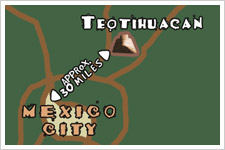 When the Aztecs stumbled on the city of Teotihuacan in the fourteenth century, it was already in ruins. The origins of the people who lived here and why they abruptly disappeared remain a mystery today.
When the Aztecs stumbled on the city of Teotihuacan in the fourteenth century, it was already in ruins. The origins of the people who lived here and why they abruptly disappeared remain a mystery today.
Just 30 miles outside of Mexico City, the dramatic ruins of Teotihuacan are easily visited in a day.
Without the wheel or beasts of burden, men built this city in the 1st century BC, hauling millions of stone blocks with brute strength. One of the largest cities in the ancient world, Teotihuacan grew to great prominence as a hub for commerce and trade as well as a religious center. The Aztecs, discovering the ruins, gave the city its name—Teotihuacan, or City of the Gods, as they believed the Gods they worshipped were born here.
The Temple of the Sun, the largest structure in the city, is built over a cave and possibly a spring—sacred places for Mesoamerican people.
The Palace of the Quetzal butterfly, adjacent to the Temple of the Sun, is a beautifully preserved house of a priest or ruler. Reliefs of the mythological bird/butterfly hybrid are carved into the courtyard columns. Painted jaguars adorn one of the underground palace rooms and bird motifs decorate another chamber.
The most magnificent sculptures in the ruined city adorn the Temple of Quetzalcoatal. The Aztecs believed that Quetzalcoatal, the god of the wind, the sky and creator of man, would one day return. When Cortes arrived, he was mistaken for the god and welcomed by the Aztecs – big mistake.
In the 8th century, a huge fire raged through Teotihuacan. By that time, the population had declined somewhat, but who caused the destruction or why the city was finally abandoned, no one is certain.
TIP
Hotels can arrange day trips with guides to Teotihuacan.
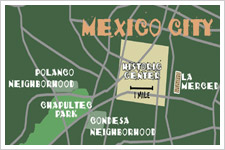 Back in Mexico City, neighborhood restaurants and cafes are opening, people are out for their late afternoon paseo. The latest neighborhood hot spots are youthful Condesa and glamorous Polanco.
Back in Mexico City, neighborhood restaurants and cafes are opening, people are out for their late afternoon paseo. The latest neighborhood hot spots are youthful Condesa and glamorous Polanco.
Art deco houses, pleasant little parks and artsy shops, Condesa once housed bohemians and revolutionaries in the 1930s. I repeatedly found myself drawn back to Condesa—for an afternoon stroll, a drink at a café or dinner in one of the many open air restaurants. Nearby, Polanco, is the chicest of neighborhood in Mexico City. All the big name boutiques are here as well as little corner cafes and shops. In nearby residential streets are some of the most beautiful and carefully guarded houses in Mexico City.
Set on Mexico City’s version of Rodeo Drive in Polanco, Patricia Quintana’s restaurant Izote is drawing raves. Quintana is a star in Mexico, celebrated for her cookbooks and TV appearances. Izote dazzles with stunning dishes, sensational salsas and piccante chili sauces.
TIP
The restaurant's address is 513 Avenue Presidente Masaryk.
For a complete change of pace, I’ve traded city life for the soothing waters on the Pacific coast. A short flight from Mexico City or a day’s drive, the palm fringed resorts Ixtapa and Zihuatanejo are bathed in golden light and crystal clear water.
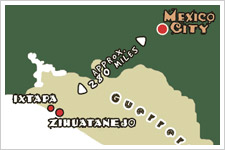 Ixtapa is a resort town with high rise hotels and a long, pretty beach with surf that can often be too rough for swimming.
Ixtapa is a resort town with high rise hotels and a long, pretty beach with surf that can often be too rough for swimming.
Four and a half miles south, Zihuatanejo is the antithesis of Ixtapa. The beaches are safe for swimming and other water sports and the streets of the town quaint and peaceful.
Tough day planned today: the beach for breakfast, the beach at lunch, a little shopping and then the beach for sunset.
Zihuatanejo’s main beach, Playa Municipal is a great place to start the day. Fisherman drag their catch and colorful boats on shore every morning. Deep sea fishing trips depart here and your day’s catch can be cooked up at local restaurants.
A pangas or water taxi, runs every ten minutes to nearby Playa las Gatas, a great spot for lunch. You can dine on fresh seafood and watch the beach scene from under thatched palapas.
Sailboat and windsurfers dot the pale blue sea. Snorklers can explore the tiny reef at the beach’s outer edges.
Centuries ago, pirates hid out in Zihuatenjo, poised to attach passing Spanish galleons.
Zihuatanejo town’s colorful streets are jammed with artisan markets. The specialty shop Coca Cabana Collectibles, run by a former New York gallery owner, has an eye catching collection of art from across Mexico.
Legend has it that pirates attacked a Spanish ship laden with silk—and the clothes washed ashore giving Playa La Ropa its name. This is Zihuatenjo’s prettiest beach and the place to come for sunset in paradise.
From the hustle and bustle of Mexico City to the quiet mystery of Teotihuacan to sun burnt pacific beaches, Mexico dances its way into your heart. The teeming capitol, rich in history and culture, endlessly entertains and enlightens. For centuries it has been the lively center of this varied and beautiful land.
Well, here’s to the end of another day for the Mexican sun god. Like Mexico itself, sunset on the Playa La Ropa is a dramatic explosion of color and energy. From this enchanting land, adios and buenos noches.
- Introduction
- The Zocalo
- Temple Mayor Museum
- La Merced
- Chapultepec Park
- Museum of Anthropology
- La Ciudadela
- Plaza Garibaldi & Mariachi
- Zinco Jazz Club
- Ballet Folklorico
- Marquis Reforma Hotel
- Museo Mural Diego Rivera
- Palacia Nacionale
- Teotihuacan
- Condesa Neighborhood
- Restaurant Izote
- Ixtapa & Zihuatanejo
- Playa Las Gatas
- Coca Cabana Collectibles
- Playa La Ropa
- Buenos Noches...

